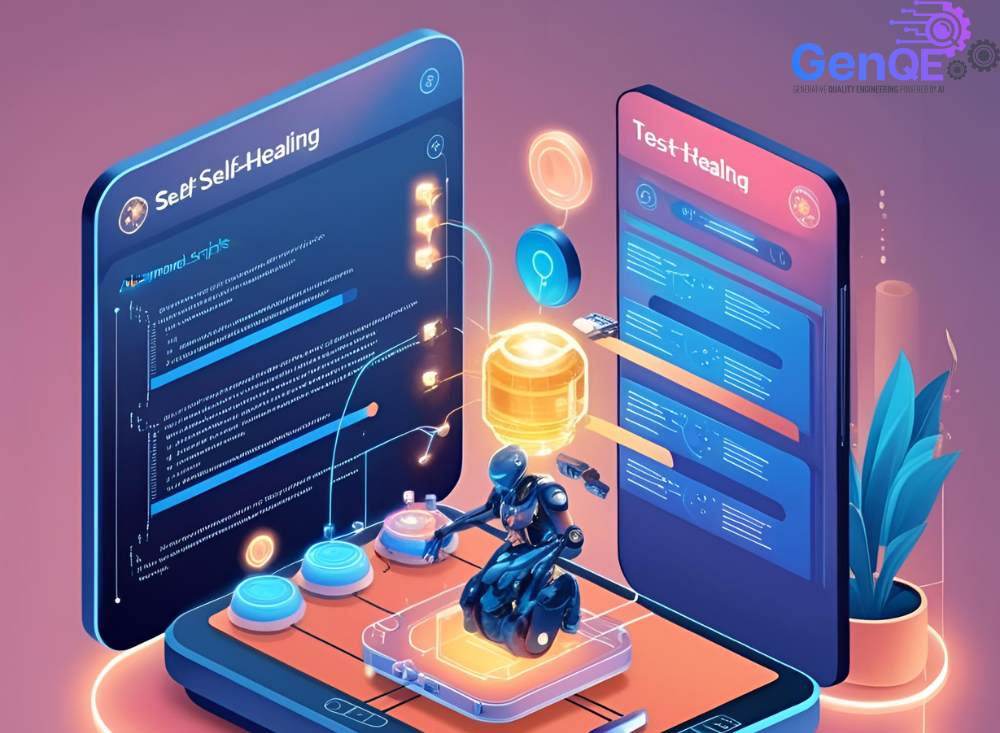
In the fast-paced world of software development, maintaining test scripts can be a daunting task. Frequent updates to user interfaces (UI) and application logic often lead to broken tests, requiring significant time and effort to fix. Enter self-healing test automation, a revolutionary approach powered by Artificial Intelligence (AI) that enables test scripts to adapt to UI changes automatically. In this article, we’ll explore how AI is driving this transformation, the implementation strategies, and the impact on test maintenance costs and team productivity. We’ll also discuss the challenges and the future of self-healing test automation, with a focus on how Genqe.ai is leading the charge.
How AI Enables Tests to Adapt to UI Changes Automatically
Self-healing test automation leverages AI and machine learning to identify and fix broken test scripts without human intervention. Here’s how it works:
- Dynamic Element Identification: AI algorithms analyze the application’s UI and identify elements dynamically, even if their attributes (e.g., IDs, class names) change.
- Change Detection: The system detects changes in the UI and updates the test scripts accordingly.
- Automatic Corrections: If a test fails due to a UI change, the AI-driven system identifies the root cause and applies the necessary fixes.
- Continuous Learning: The system learns from past changes and failures, improving its ability to handle future updates.
Self-Healing Implementation Strategies and Success Stories
Implementing self-healing test automation requires a strategic approach. Here are some key strategies and real-world success stories:
1.Integrate AI-Powered Tools
- Use tools like Genqe.ai to automate test script maintenance and enable self-healing capabilities.
- Success Story: A leading e-commerce platform reduced test maintenance efforts by 70% after integrating Genqe.ai self-healing features.
2.Adopt Continuous Testing Practices
- Integrate self-healing test automation into your CI/CD pipeline to ensure continuous testing and rapid feedback.
- Success Story: A fintech company achieved a 30% reduction in release cycles by implementing continuous testing with self-healing capabilities.
3.Train Teams on AI-Driven Testing
- Educate your QA teams on the benefits and usage of self-healing tools to maximize their effectiveness.
- Success Story: A healthcare software provider improved team productivity by 30% after training its QA team on Genqe.ai self-healing features.
Impact on Test Maintenance Costs and Team Productivity
Self-healing test automation has a profound impact on both cost and productivity:
- Reduced Maintenance Costs: By automating the process of fixing broken tests, organizations can significantly reduce the time and resources spent on test maintenance.
- Improved Team Productivity: QA teams can focus on higher-value tasks, such as exploratory testing and test case design, rather than fixing broken scripts.
- Faster Release Cycles: With fewer test failures and quicker fixes, organizations can accelerate their release cycles and deliver software faster.
Self-Healing Challenges and Premonitions
While self-healing test automation offers numerous benefits, it also comes with challenges:
- Complex UI Changes: Some UI changes may be too complex for AI to handle automatically, requiring manual intervention.
- False Positives/Negatives: The system may occasionally misinterpret changes, leading to incorrect fixes or missed issues.
- Initial Setup Costs: Implementing self-healing capabilities requires an initial investment in tools and training.
- Over-Reliance on Automation: Teams may become overly reliant on self-healing tools, neglecting manual testing and exploratory efforts.
Premonition: As AI continues to evolve, these challenges will likely diminish, making self-healing test automation even more effective and accessible.
Future of Self-Healing Test Automation
The future of self-healing test automation is bright, with several exciting developments on the horizon:
- Enhanced AI Capabilities: Advances in AI and machine learning will enable self-healing systems to handle more complex UI changes and scenarios.
- Integration with DevOps: Self-healing test automation will become an integral part of DevOps practices, enabling seamless continuous testing.
- Wider Adoption: As tools like Genqe.ai become more sophisticated and affordable, more organizations will adopt self-healing test automation.
- Proactive Testing: AI-driven systems will not only fix broken tests but also predict potential issues and suggest preventive measures.
Conclusion
Self-healing test automation is revolutionizing the way organizations approach software testing. By leveraging AI-powered tools like Genqe.ai, teams can reduce test maintenance costs, improve productivity, and accelerate release cycles. While challenges remain, the future of self-healing test automation is promising, with advancements in AI and machine learning paving the way for even greater efficiencies.
Embrace the power of self-healing test automation today and transform your testing processes. With Genqe.ai, you can ensure that your test scripts adapt to changes automatically, allowing your team to focus on delivering high-quality software faster and more efficiently. The future of testing is here — are you ready to take the leap?